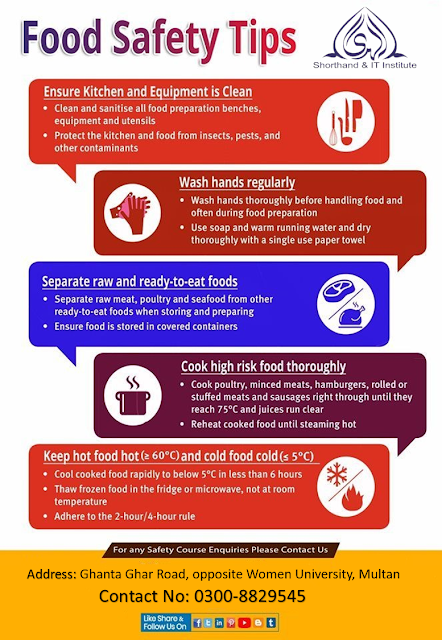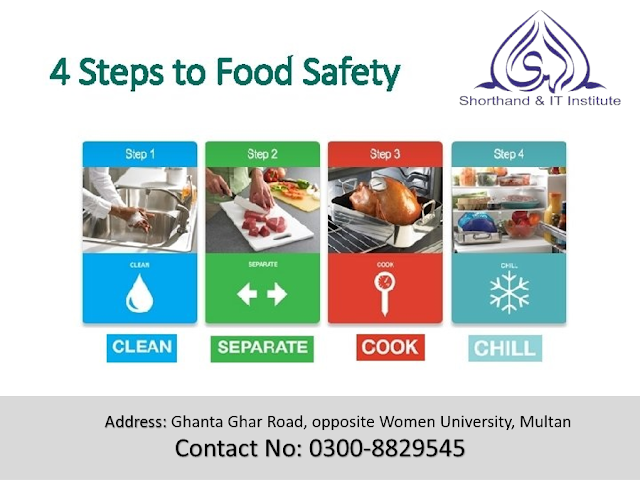Aspects of Nutritional Security
When it comes to keeping food safe, food safety is all about
ensuring that foodborne illness and injury are prevented. Food products may be
exposed to a variety of health hazards as they move through the supply chain.
So, to avoid these dangers and protect consumers, safe food handling practices
and procedures are required at each stage of the food product's life cycle.
In food safety, a wide range of academic fields are
involved, including chemistry and microbiology. Food processing safety is ensured
wherever food products are sourced, manufactured, prepared, stored, or vended
by these various seminaries of study. As a systemic approach to hygiene and
responsibility, food safety encompasses all aspects of global food assiduity.
The importance of food safety in the global food supply
chain is discussed in detail in the Food Safety Course in Multan composition.
An overview of the various non-supervisory bodies in charge of food safety
around the world is followed by an in-depth discussion of effective food safety
regulation, as well as the history of food safety and its consequences for
businesses and consumers.
Preparing & Cooking Food
All fresh ground meat, a variety of flesh, flesh, or fish is
frozen within two days, as Janice is taught by the Multan Culinary Food Safety
Course in Multan.
Janice ensures that she's ready to cook when she's ready to
regale.
Vegetables, fruits, and other non-meat items should be
stored away from meat, flesh, and fish.
Clean and hot water should be used to clean all the cookware and countertops that were used to cut these raw ingredients for cooking.
Using a solution of 1 teaspoon of unscented, liquid chlorine
bleach mixed with 1 gallon of water, students taking the Food Safety Course in
Multan can disinfect the cookware and countertops used to cut raw meat, flesh,
and fish.
Refrigerate any meat or flesh that has been marinated.
Everything Janice does in her kitchen is done in accordance
with a well-known food safety form she has graciously shared with us.
All beef, angel, pork chops, repast, and veal are cooked to
at least 145F.
The Importance of Safe Food
Ignoring the importance of food safety by thinking that the
Food Safety Course in Multan only serves as a commodity for cufflinks and food
shops is a serious omission.
Food poisoning can be spread by contaminated food that has been tainted by bacteria, viruses, or sponges. Getting food poisoning can be extremely dangerous.
The appearance, flavor, and odor of tainted food may be
identical to those of untainted food. You won't be able to tell the difference
if you don't understand food safety.
Because of their weakened immune systems, infants, children,
the elderly, and women who are pregnant are more likely to contract food
poisoning.
Types of Hazards
You need to take into
account four different types of dangers.
Threats posed by microbes
Food is contaminated by microorganisms when they grow in the
air, food, water, soil and animals, and the human body. There are numerous
microorganisms that are beneficial and necessary for life itself to learn about
in Multan Food Safety Course. Nonetheless, some microorganisms can cause
foodborne illness under the right circumstances. Bacteria, contagions, and
spongers are the most common microorganisms associated with foodborne illness.
The dangers posed by chemicals
It is important to be aware of the potential dangers of a
wide range of chemicals in everyday items such as drinking water, food-contact
accessories, drawing agents, pest control substances, pollutants (such as
acrylamide in the environment), fungicides, biocides, and food-complements.
Physical dangers
The majority of physical hazards are caused by accidental
contamination and/or poor food handling. To name a few, examples include broken
or minced glass splinters and toothpicks with frilled ends; mortal hair; nails;
false nails; nail polish; pieces of jewelry; and essence fractionalized from
worn or minced implements and holders
Water and a recollection of the face are the most common
methods for removing these residues.
The process of irradiation eliminates pathogenic and
corrupting microorganisms without compromising food safety, nutritional value,
or product quality, all while extending the shelf life of food. As a general
rule, spices are irradiated as a means of controlling bacterial growth and
soil.










1 Comments
thank you so much for sharing an amazing blog post regarding health and safety.
ReplyDeletea team of experienced professionals is here to guide a new career in the health and safety field. our courses include, nebosh,iosh,othm, hse, etc for more details feel free to contact us. top nebosh training institute in Ernakulam. call us to find the best course for your career.